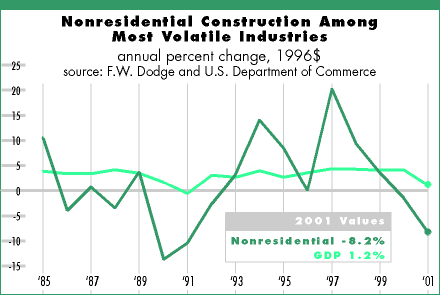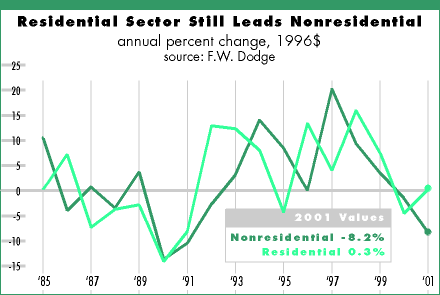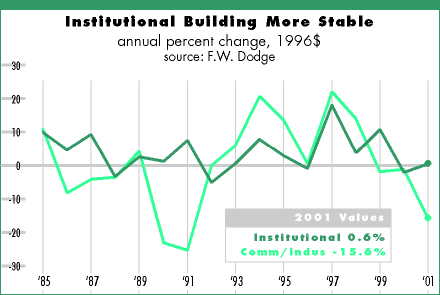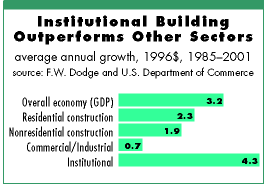
Institutional building, while the most stable,
also has shown the most growth in recent decades

AIA Chief Economist
After posting strong and sustained growth between 1993 and 1999, construction contracts for nonresidential buildings declined slightly in 2000 (after adjusting for inflation) and then dropped more substantially last year. It was hoped that the "new economy" of the 1990s—one based on technology investments and worker productivity gains—was an economy that would negate the business cycle. Because recessions are typically caused by imbalances between production and consumption, the theory was that better information would help restore this balance.
Architects and others working in the nonresidential construction industry are now painfully aware that business cycles are again very much a part of business life. Nonresidential construction levels began to soften in late 2000 and were weaker throughout last year as the overall economy headed into recession. When the economy turns down, construction traditionally experiences a more substantial decline.
Regular blips cause
construction spikes
Growth or decline in the overall economy stays in a fairly narrow range.
Between 1985 and 2001, annual growth in our economy (again adjusted for
inflation) ranged from a low of -0.5% in 1991 to a high of 4.4% in 1997.
However, a modest blip in the economy typically produces a substantial
spike in nonresidential construction activity.
For example, during the same 1985–2001 period, growth in nonresidential construction contracts ranged from -13.6% to 20.3%. Over these 17 years, contracts increased at a high single-digit or a double-digit pace during five years and declined at a high single-digit pace or a double-digit pace during three years. So, in 8 of these 17 years, the industry experienced either very strong growth or steep declines, demonstrating its volatility. And the volatility in recent years has been just as pronounced as it was in the 1980s, so the new economy doesn't seem to have done much to reduce the cyclical nature of nonresidential construction activity.

Even the residential market, commonly cited as a key reason for why this national economic recession has been relatively mild, has continued to exhibit considerable volatility. It's just that few of the major swings have taken it into negative territory in recent years. While F.W. Dodge reports that residential activity declined each year between 1987 and 1992, there have been only two small annual declines over the past decade. Housing, due to low mortgage rates, has held up surprisingly well during this recession. Still, the cyclical pattern for residential construction has fairly accurately anticipated the nonresidential construction cycle.

Institutional construction
is the most stable
Construction of institutional buildings has continued to be much more
stable than its commercial and industrial counterparts. While construction
contracts for commercial and industrial buildings have declined at a double-digit
annual pace three times since 1985, institutional construction contracts
have not fallen by more than 5% during any year over this period. And
while the commercial/industrial market has seen double-digit gains six
times over this period, institutional buildings saw that pace of growth
in only three years. Still, there is no evidence that either of these
sectors has seen less volatility in recent years compared to cycles in
the late 1980s and early 1990s.

If the less volatile swings in institutional construction levels are not enough to convince architects of the benefits of working in the institutional sector, there is another reason that may be more compelling. On average, construction contracts for institutional building have increased by 4.3% per year since 1985. This pace of growth not only far surpasses growth rates for commercial/industrial buildings, it also is well in excess of the growth in residential activity and has outpaced average growth in the overall economy.
 This
impressive performance in the institutional sector is largely due to demographic
trends, which have encouraged a significant surge in the construction
of school, justice, and health-care facilities. Still, the combination
of relatively stable levels of construction and strong growth rates has
made the institutional sector a lucrative market for many architecture
firms.
This
impressive performance in the institutional sector is largely due to demographic
trends, which have encouraged a significant surge in the construction
of school, justice, and health-care facilities. Still, the combination
of relatively stable levels of construction and strong growth rates has
made the institutional sector a lucrative market for many architecture
firms.
Copyright 2002 The American Institute of Architects. All rights reserved.
![]()
|
|
|